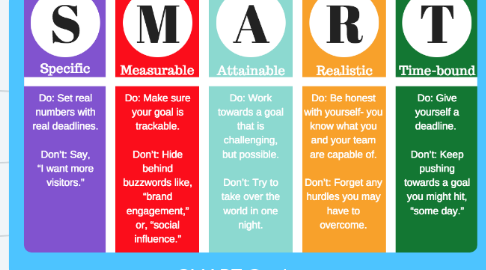SMART Goals
by Sinan Sensivas


1. Specific
1.1. To set a specific goal, you must first answer the six “W” questions:
1.2. Who- Who is involved?
1.3. What- What do you want to accomplish?
1.4. Where- Identify a location.
1.5. When- Create a timeframe.
1.6. Which- Identify requirements and constraints.
1.7. Why- Identify specific reasons, a purpose, or benefits of accomplishing the set goal.
2. Measurable
2.1. Establish the criteria for measuring your progress while you work towards your goal.
2.2. Ask yourself questions like: How much? How many? And, how will I know when I achieve my goal?
3. Attainable
3.1. When you identify your goal and determine how you are going to achieve your goal, you see how attainable it is and how much effort it will require.
3.2. Look at the workload associated with this goal and be sure that it will not get in the way of other projects you are working on and that you will be able to dedicate enough time to achieving your goal.
4. More Info
4.1. Source
4.1.1. The Importance of Setting SMART Goals
